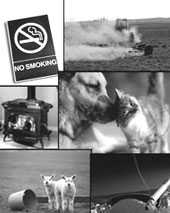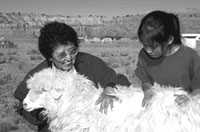Asthma Among Household Youth on Minority Farm Operations
December 2003
DHHS (NIOSH) Publication Number 2004-118



Normal Airway (left), Airway with Asthma (right)
What is Asthma?
- Asthma is an inflammatory condition of the bronchial airways in the lungs caused by allergens, irritants and respiratory infections (like colds and flu)
- This inflammation causes difficulty breathing, chest tightness, coughing, and wheezing
- More than 14 million people in the United States suffer from asthma
What about Childhood Asthma?
- Asthma is the most common chronic disease of childhood
- Over 5 million children have asthma
- About 9 children out of 100 have asthma
- Asthmatic school aged children miss 14 million days of school each year
- Asthma has increased dramatically in children since the 1980s
What are the Symptoms of Asthma?
- Frequent coughing
- Wheezing
- Frequent respiratory infections, like colds and flu
- Chest tightness
- Trouble breathing
- Frequent night coughs
- Coughing after crying, laughing, or physical activity
What Triggers Asthma?
Parents should be aware of the unique triggers that are present on family farms such as wood smoke, fertilizers, pollen from crops and weeds, and chemicals, as well as areas high in mold such as feed and storage facilities.
Parents should be prepared to take the steps they can in order to avoid exposing asthmatic children to these unique triggers.
- Exercise, particularly running
- Respiratory infections, like colds and flu
- Allergies
- Cigarette smoke, fumes, dust mites, animal dander, cockroaches, mold, pollen, strong odors, sprays, and other irritants
- Weather, particularly cold air
- Emotional stress or excitement

Asthma Among Household Youth on Minority Farm Operations
Household farm youth comprise all youth 0-19 years of age who live on the farm and include working and non-working youth.
- In 2000, approximately 28,600 youth lived on minority farm operations:
2,500 household youth had been diagnosed with asthma (88 asthmatics per 1,000 youth living on minority farm operations) - 10-15 year olds had the highest prevalence rate of asthma (102 asthmatics per 1,000 youth living on minority farm operations)
- 530 household youth required professional medical attention for asthma (19 asthmatics per 1,000 youth living on minority farm operations)
- 813 household youth had at least one asthma attack in the last year while doing farm work (69 asthmatics per 1,000 youth living on minority farm operations)
- Youth less than 10 years of age had the highest prevalence rate for having an asthma attack while doing farm work (124 asthmatics per 1,000 youth living on minority farm operations)
You Can Prevent Asthma Attacks by Knowing the Triggers
- Learn what triggers attacks for your child
- Avoid triggers that bring on attacks, such as cigarette smoke, diesel exhaust and fertilizers
- Limit work and play outside when air pollution and pollen levels are high
- Keep asthmatic children away from farm areas high in mold irritants– storage areas, feed mixing work areas, hay, etc.
- If possible, do not use a wood-burning stove, kerosene heater, or fireplace

Education is the Key to Prevention!
Parents can control their child's asthma and help them become symptom free most of the time. Parents should note that asthma does not go away when their child's symptoms clear up.
- Educate your children about how to appropriately manage their asthma
- Educate yourself about ways to prevent and treat asthma
- Make sure you tell family members, playmates, and teachers what to do in case your child has a severe asthma attack
- You need to work with a physician on a plan to reduce your child’s asthma
- You should visit your child’s physician every six months
- You should know that allergy injections may reduce asthma attacks
- You need to make sure children are taking proper medication– along with the proper amount and duration
Need More Information?
Allergy and Asthma Network Mothers of Asthmatics
2751 Prosperity Avenue, Suite 150
Fairfax, Virginia 22031
Telephone: 800-878-4403; 703-641-9595
Asthma and Allergy Foundation of America
1233 20th Street NW
Washington, DC 20036
Telephone: 1-800-7-ASTHMA (202-466-7643)
National Asthma Education and Prevention
Program (NAEP)
National Heart, Lung, and Blood Institute Information Center
P.O. Box 30105
Bethesda, Maryland 20824-0105
Telephone: 301-592-8573
INSURE KIDS NOW!
Your state, and every state in the nation, has a health insurance program for infants, children, and teens. The insurance is available to children in working families. To learn more, make a free call to find your State’s Program.
Children’s Health Insurance Program (CHIP)
U.S. Department of Health & Human Services
Telephone: 1-877-KIDS-NOW (1-877-543-7669)
Asthma Among Household Youth on Minority Farm Operations [PDF - 429 KB]
- Page last reviewed: June 6, 2014
- Page last updated: June 6, 2014
- Content source:
- National Institute for Occupational Safety and Health Education and Information Division


 ShareCompartir
ShareCompartir